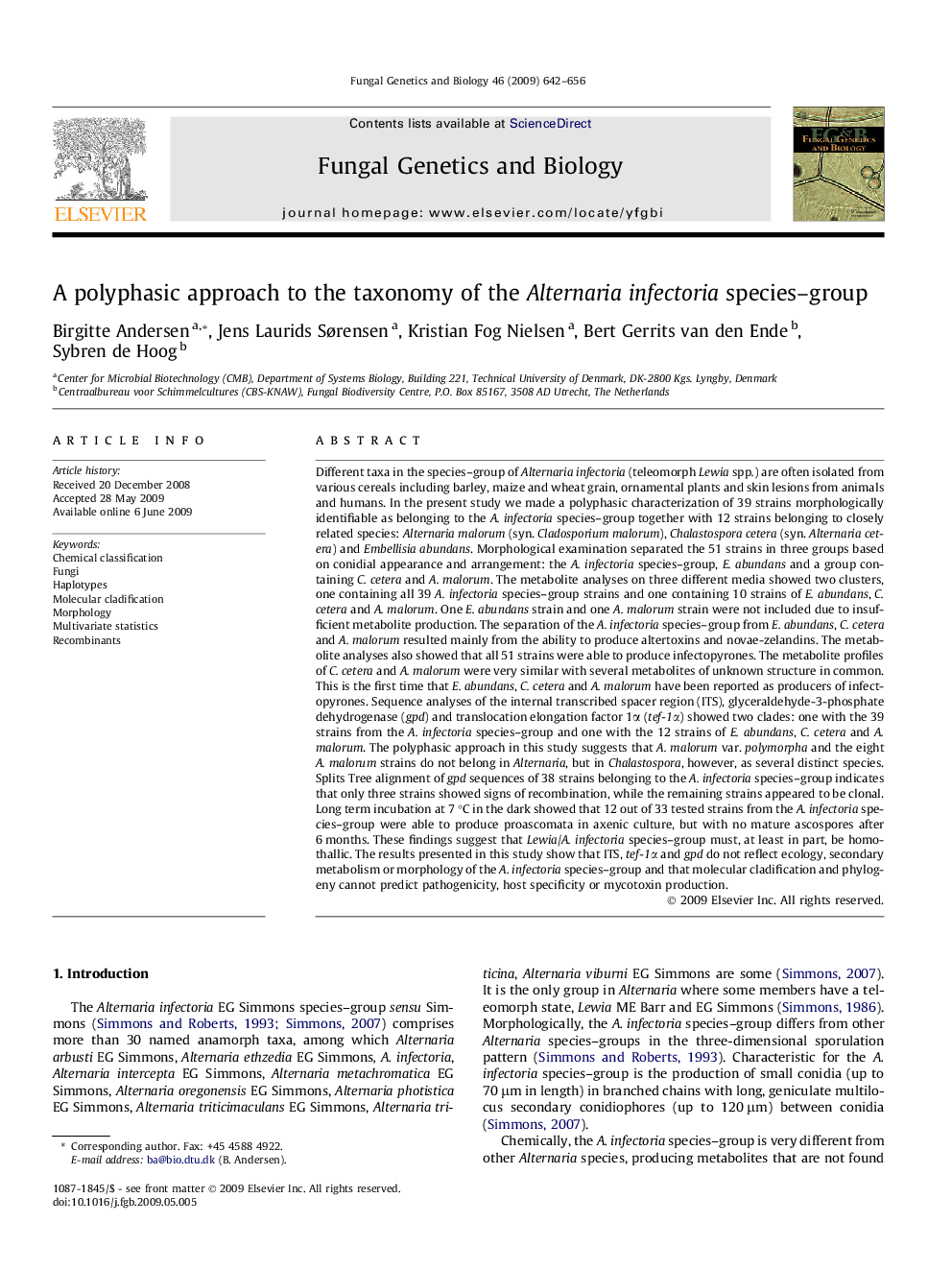| Article ID | Journal | Published Year | Pages | File Type |
|---|---|---|---|---|
| 2181242 | Fungal Genetics and Biology | 2009 | 15 Pages |
Abstract
Different taxa in the species-group of Alternaria infectoria (teleomorph Lewia spp.) are often isolated from various cereals including barley, maize and wheat grain, ornamental plants and skin lesions from animals and humans. In the present study we made a polyphasic characterization of 39 strains morphologically identifiable as belonging to the A. infectoria species-group together with 12 strains belonging to closely related species: Alternaria malorum (syn. Cladosporium malorum), Chalastospora cetera (syn. Alternaria cetera) and Embellisia abundans. Morphological examination separated the 51 strains in three groups based on conidial appearance and arrangement: the A. infectoria species-group, E. abundans and a group containing C. cetera and A. malorum. The metabolite analyses on three different media showed two clusters, one containing all 39 A. infectoria species-group strains and one containing 10 strains of E. abundans, C. cetera and A. malorum. One E. abundans strain and one A. malorum strain were not included due to insufficient metabolite production. The separation of the A. infectoria species-group from E. abundans, C. cetera and A. malorum resulted mainly from the ability to produce altertoxins and novae-zelandins. The metabolite analyses also showed that all 51 strains were able to produce infectopyrones. The metabolite profiles of C. cetera and A. malorum were very similar with several metabolites of unknown structure in common. This is the first time that E. abundans, C. cetera and A. malorum have been reported as producers of infectopyrones. Sequence analyses of the internal transcribed spacer region (ITS), glyceraldehyde-3-phosphate dehydrogenase (gpd) and translocation elongation factor 1α (tef-1α) showed two clades: one with the 39 strains from the A. infectoria species-group and one with the 12 strains of E. abundans, C. cetera and A. malorum. The polyphasic approach in this study suggests that A. malorum var. polymorpha and the eight A. malorum strains do not belong in Alternaria, but in Chalastospora, however, as several distinct species. Splits Tree alignment of gpd sequences of 38 strains belonging to the A. infectoria species-group indicates that only three strains showed signs of recombination, while the remaining strains appeared to be clonal. Long term incubation at 7 °C in the dark showed that 12 out of 33 tested strains from the A. infectoria species-group were able to produce proascomata in axenic culture, but with no mature ascospores after 6 months. These findings suggest that Lewia/A. infectoria species-group must, at least in part, be homothallic. The results presented in this study show that ITS, tef-1α and gpd do not reflect ecology, secondary metabolism or morphology of the A. infectoria species-group and that molecular cladification and phylogeny cannot predict pathogenicity, host specificity or mycotoxin production.
Related Topics
Life Sciences
Biochemistry, Genetics and Molecular Biology
Cell Biology
Authors
Birgitte Andersen, Jens Laurids Sørensen, Kristian Fog Nielsen, Bert Gerrits van den Ende, Sybren de Hoog,
